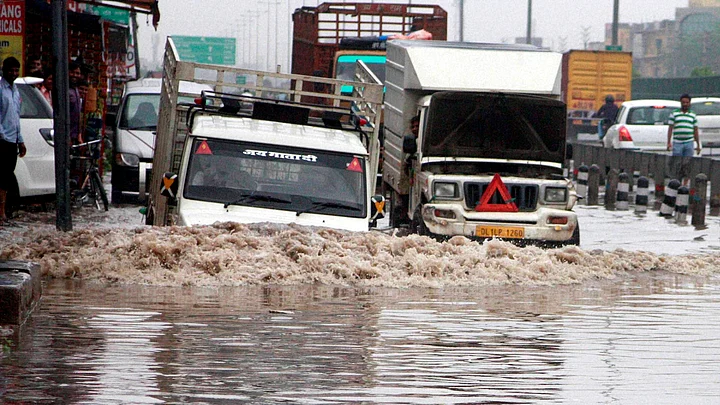Wake up and smell the coffee, New Delhi!
Don’t make fun of Gurugram. Traffic jams there may last 10 hours, but the day you receive six to eight centimetres of rainfall within the span of a couple of hours, you too will come to a standstill.
Gurugram’s Flawed Town-Planning

- Low lying Gurugram receives surface run off from the Aravallis and Chhatarpur. This run off used to flow through Badshahpur Nala.
- Badhshahpur Nala was a channel that would transport the run off from the plains to streams and rivers. It was part of a large network of tributaries in a greater riverine system.
- This tributary was responsible not only for the criss cross irrigation of this land, but worked as an aquifier which is pivotal for the replenishment of the sub soil.
- The Nala would only be filled in monsoons, and it was seen as a royal waste of real estate paradise for the rest of the year. It was subsequently encroached upon and concretised by town planners.
- Natural patterns of drainage were ignored. Individual builders created their own little artificial drainage systems for each property, and none of these were in sync with the rest. No macro plan for drainage in Gurgaon was formulated.
- Concrete drains disallow rain water from being absorbed and make replenishment of the sub soil close to impossible. There is no way for the rain water to percolate into the soil, leading to severe waterlogging.
Impending Doom for Delhi
Delhi is close to joining the club. On Monday, after a downpour, all arterial roads were clogged and the resultant traffic jams were never ending. South and Central Delhi was already a waterlogged mess.
Storm water drains, technically tributaries of the Yamuna and Hindon are being concretised all over Delhi. Apart from roads and car parks, Dilli Haat is an example of construction on top of a nala.
With the rate at which global warming is picking up, flooding and incessant rain is something that should be expected. A reverse flow hitting Delhi is expected. Gurgaon had a single drain, whereas Delhi has dozen major drains including Chirgh Dilli, Sewa Nagar, Najafgarh etc. The probability of the sewage system packing up is also looming.

Delhi unlike Gurgaon has no open spaces, where standing water can be diverted as it is surrounded on all sides. The British had foreseen the propensity of the plains of Burari to flood, and refused to develop it. That area now exists as Model Town, Okhla, Geeta Colony and Shakarpur.
The floods in 1980s can definitely reoccur, where Model Town, ISBT Road etc were completely inundated. Since then, most nalas have been made narrower and the Yamuna even has a temple placed inside it.
Shockingly, many nalas like the one in Defence Colony and behind AIIMS, have concretised beds as well as pillars supporting roads on top of it.
Covering drains will result in not being able to spot obstructions or reverse flow in the nalas. No monitoring systems have been set up.
Finding an Escape Route
Construction in low lying and flood plain areas of the Yamuna and concretisation of nalas, pavements in Delhi needs to be prohibited. Sewage treatment plants need to be set up along the course of drains, and only treated sewage should be discharged in drains.
Nalas need to be opened, and roads built over them need to be removed so that they can go back to being tributaries of clean water. The quality of the sub soil and Yamuna will gradually improve.
Setting up of rain water harvesting systems will substantially help in replenishing sub soil water. Civic staff needs to be trained and educated accordingly.

The State needs to set up suitable precedent as well. Setting up the Akshardham Temple, and the CWG Village promoted an attitude of ruthlessness towards the flood plains.
The Centre and states need to work together and bodies like the DDA need to be stopped from auctioning land to real estate moguls. They should also be more mindful of the needs of the poor.
(Source: The Huffington Post)
(At The Quint, we question everything. Play an active role in shaping our journalism by becoming a member today.)
